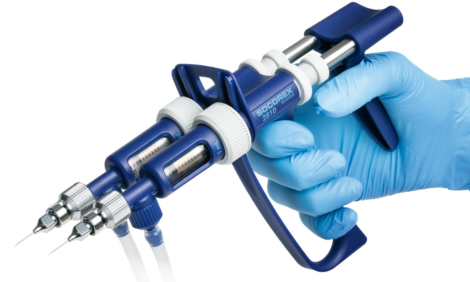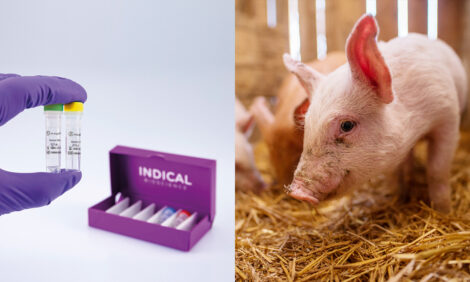



Impact on Hog Feed Cost of Corn and DDGS Prices
By John Lawrence - Corn is currently the largest ingredient cost item in the feed costs. This Iowa Farm Outlook will address three key questions pork producers are facing.Rising corn prices this fall have resulted in higher feed cost for hog producers. Depending on feed efficiency and cost of facilities, feed cost is typically 50-60% of total cost of production for pork producers.
- What is the impact on cost of production of higher corn prices?
- How does higher feed cost impact the optimal marketing weight for hogs?
- Can including distillers dried grains and solubles (DDGS) reduce feed cost for pork producers?
Corn Price and Feed Cost...
Typically, approximately 79-80 percent of the feed that grow-finish hogs consume is corn. Table 1 lists four diets for grow-finish hogs based on a University of Minnesota research trial evaluating the impact on hog performance and carcass characteristics of different levels of DDGS. These results are based on research published in the Journal of Animal Science, July 2006. The first column is similar to a commercial ration without DDGS.

The impact of higher corn prices in conventional diets can be estimated using the DDGS0 diet as a proxy for a commercial corn-SBM diet. Table 2 lists three input price scenarios. The Current scenario represents prices in early November 2006. The Lower scenario is prices from August 2006. The Higher scenario is potential prices that may occur as the corn market tries to encourage more corn plantings in 2007.

Comparing the feed cost per hog between the Current and Lower columns show the impact of a $1/bu and $10/ton increase in corn and SBM prices, respectively. This difference is approximately $9/head for the 200 pounds of gain assumed in this example, or about $4.50/cwt of carcass weight sold. The hogs in this research trial were quite efficient with feed:gain ratios under 2.8 for the control group (Table 3).
Whole pen closeouts in a commercial setting and hogs sold at a heavier weight are not likely to be as efficient. When the feed cost for the nursery and breeding herd is included the feed cost increase is closer to $5/cwt of carcass. Producers with different diet formulations or different efficiencies will have different results.
Optimal Marketing Weight...
Although the change is not dramatic, efficiency of gain decreases as hogs grow larger. For example, the average feed:gain ratio from 50-260 pounds may be 3.2, but the ratio from 250-260 pounds is closer to 4.1. The economically optimal time to sell is when the cost of the last pound is equal to the revenue from the last pound.
Feed prices obviously impact the cost of the additional pound. In our 4.1 feed:gain example, the feed cost of one more pound of live weight gain at $.06/lb. feed is $.246. If hog prices are $.40/lb live it makes sense to put on the additional pound. However, the revenue side is not typically that simple. First, the lean premium and sort discounts change as hogs change weight. The net price may increase initially, but decrease at heavier weights as more hogs exceed the top of the weight range and put on more fat. Second, market prices may change before the animals are sold. Seasonal price patterns can help predict the probability of price changes at a particular time of the year. It is also important to note that the price change and discounts are applied to all pounds and not just the last pound added.
The bottom line is that if the hogs were marketed at the optimal weight with $2/bu corn, the optimal marketing weight with $3/bu corn will be less. A spreadsheet tool to help producers evaluate optimal marketing weight is available at http://www.econ.iastate.edu/faculty/lawrence/Hog%20Market%20Calculator%20Advanced.xls.
Feeding DDGS to Reduce Costs...
The impact of replacing a portion of the corn and SBM in the diet with DDGS is summarized in Tables 3, 4, and 5. The U of MN researchers found no difference in performance or carcass traits with DDGS at 10% of the diet throughout the grow-finish phase. Average daily gain was lower at the 20% and 30% levels than at the 0% and 10% levels, and the 30% ADG was lower than the 20% ADG. The DDGS30 also required more feed per pound of gain than did the other three diets that were alike. As a result of the lower ADG, the DDGS20 and DDGS30 had lower selling weights for the same number of days on feed.
There was no statistical difference in carcass lean, but the DDGS20 and DDGS30 had a lower dressing percentage. There was no statistical difference in muscle color, water holding capacity, or tenderness due to the level of DDGS in this trial. While not reported here and not currently discounted at packing plants, belly fat became more unsaturated as the dietary concentration of DDGS increased. The more unsaturated the fat, the softer the belly fat, causing problems for bacon slicers and some export customers.

Table 4 shows the impact on the price per pound of feed and cost per pound of gain at different levels of DDGS across three feed price levels shown in Table 2. Increasing the level of DDGS in the ration reduced the feed price per pound under each of the price scenarios. It is possible that DDGS can be priced higher than the corn and SBM it replaces and in that case it would not be beneficial to use DDGS. Each 10% increase in DDGS in the ration reduced the feed price per 100 pounds by approximately $.25 to .28.
The lower part of Table 4 is the estimated feed cost per 100 pounds of live weight gain. This calculation takes into account the feed price from the top part of the table and the performance difference from Table 3. Feed cost of gain decreased at DDGS10 and again at DDGS20, but was steady to higher at DDGS30 because of reduced animal performance.

The final analysis is to look at return over feed cost, as the level of DDGS in the ration impacts revenue through carcass weight. Table 5 assumes pigs start at equal weight of 60 pounds and are 103.5 days on feed as in the trial. This live weight was multiplied by the reported dressing percent resulting in different carcass weights. From Table 3 dressing percent was not different between DDGS0 and DDGS10 and they were both larger than DDGS20 and DDGS30 that were alike. The carcass price for treatments in this example is $60/cwt, similar to mid November prices.
These results indicated lighter carcasses for diets with higher levels of DDGS and less revenue per head. The lower part of Table 5 shows the estimated return over feed cost for the four treatments. The DDGS10 had slightly higher returns than DDGS0 because it has lower feed prices and feed cost. Returns were lower at DDGS20 and DDGS30, but the lower feed cost offset part of the decreased revenue.

Summary
Pork producers can effectively feed DDGS in grow-finish diets. Research indicates that there is no statistical difference in efficiency, growth, or carcass traits at the 10% inclusion rate compared to no DDGS in the diet. At higher levels, there is lower ADG (at 20 and 30%), higher feed:gain (at 30%), and lower dressing percentage (at 20 and 30%) compared to diets without DDGS. There was no difference in percent lean or muscle quality at the levels evaluated, but bellies were softer due to more unsaturated fat at the higher levels.
There is currently not a discount on soft pork bellies, but it is a concern of packers and the industry. At three different feed price scenarios with corn prices at $2, $3, and $4 per bushel, adding DDGS lowered feed prices and feed cost of gain. However, the reduced carcass weight resulted in less return over feed cost at the two higher inclusion rates.
November 2006








